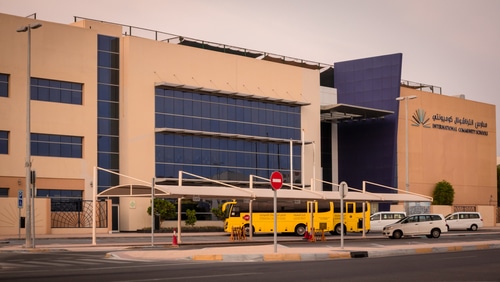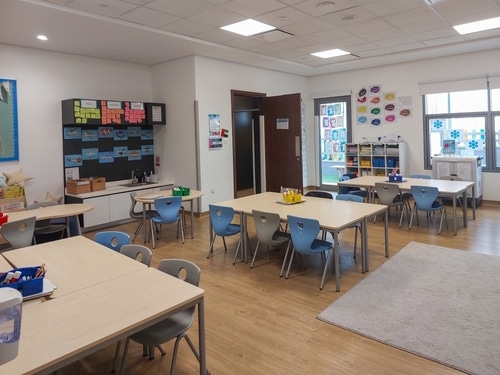At Remitly, we understand that settling into a new country can come with many important decisions. For families, one of the most meaningful decisions is education. But it can be daunting to get to grips with an entirely new school system. Education is more than just academics—it shapes a child’s development, friendships, and future opportunities. In the United Arab Emirates (UAE), the public school system is structured to provide students with a well-rounded education that meets international standards while preserving the nation’s cultural heritage.
To make the transition easier, we’ve put together this guide covering the key features of UAE public schools, to give you an understanding of the education system and what it offers children.
Comparing public and private schools in the UAE
The UAE school system consists of a mixture of public and private schools. If you’re a newcomer to the UAE and considering which type of school is right for your family, it’s worth being aware of tuition costs, the language of instruction, and the type of curriculum that best suits your child.
Public schools are funded by the government and managed by the Ministry of Education, making them a more affordable option for families. They follow a national curriculum focused on Arabic, mathematics and sciences. Arabic is the principal language of teaching, with English taught as a second language.
Private schools, on the other hand, often cater to expats and offer a wider array of international curriculums, such as British, American, and the International Baccalaureate. Private schools also tend to offer more extracurricular options.
You may want to consider your family’s priorities in terms of education, connection to the local community, and budget when making this important decision.
Understanding the UAE’s public school system
If you opt to send your child to a public school in the UAE, the system provides a well-structured academic route to help students learn and develop.
While primarily catering to Emirati students, certain public schools allow foreign students to enrol for a fee. While it is likely to be cheaper than paying for your child to attend private school, this fee might be worth bearing in mind when you’re considering the costs associated with living in the UAE.
For expat families settling into the UAE, the public school system offers an opportunity for children to learn about the local culture while receiving a solid academic foundation. Public schools can also offer children who have moved from other countries the chance to create links with the local community and better understand their new environment, its values and traditions.
This integration can help ease the transition for families, allowing children to feel more connected to their peers and surroundings. The system’s affordability also makes it an appealing option for some families as they adjust to life in the UAE.

Structure of the public school system in the UAE
In UAE public schools, students typically start their schooling at age 4 or 5 and progress through each stage until they reach the end of secondary school at around 17.
Public education is divided into three key stages: primary (Grades 1–5), lower secondary (Grades 6–9), and upper secondary (Grades 10–12). In the final stage, students choose between the General, Advanced, Professional, or Elite (Advanced Science Programme) streams, each designed to prepare them for university or vocational careers.
This approach helps make sure that students receive an education suited to their academic strengths and future aspirations.
If your child has special education needs, then it may be reassuring to know that the Federal Law No. 29 of 2006 required the safeguarding of educational rights of students with special educational needs, mandating that schools provide the necessary resources and tailored support to ensure equal educational opportunities for all children.
Enrolment process for public schools
If you are moving to the UAE from another country, enrolling in a public school is generally a straightforward process, although there are a few key things to remember.
Process and documentation
First, you’ll need to visit the school you wish to apply to, where you’ll be asked to submit documents such as your child’s passport, residency visa, birth certificate, and previous academic records.
When applying, you may be asked to provide the following documents:
- Child’s passport and valid residency visa
- Birth certificate (translated into Arabic or English)
- Proof of previous schooling (academic records or school certificates)
- Health and vaccination records
- Recent passport-sized photographs
- Emirates ID (for the child, if applicable)
- Proof of address in the UAE
- For students with disabilities, any relevant medical documentation (if applicable)
Second, once all the necessary paperwork is submitted, your child may need to undergo a placement test to assess their proficiency in Arabic, if the school follows the national curriculum.
Some schools may charge a nominal registration fee at the time of application submission. It’s worth noting that while many public schools welcome foreign students, some may prioritise Emirati children due to government funding policies.
Important timelines
The academic year in the UAE typically begins in September, and enrolment deadlines for public schools are usually set a few months prior (around May to June). Be sure to check specific school timelines as they may vary.
Keep in mind that certain schools may have waiting lists, so it’s a good idea to start the process early to avoid any delays.
Public school applications usually open in the spring or early summer for expats. Some schools may have rolling admissions, so it’s a good idea to apply early to avoid delays.
Relocating can be a daunting process, particularly when you’re navigating systems you’re not familiar with. Remitly’s blog, Without Borders is packed with helpful insights and resources to help make the transition as straightforward as possible.
FAQs
What are public schools in the UAE?
In the UAE, public schools are state-run educational institutions. These schools are managed by the Ministry of Education and follow the national curriculum, aimed at offering a balanced education that prepares students for higher education or the workforce.
How does the public school system work in the UAE?
The UAE’s public school system is structured into three key stages: primary, secondary, and post-secondary education. Students typically start their schooling at age 4 or 5 and progress through each stage until they reach the end of secondary school at around 17.
Primary education lays the foundation, focusing on key subjects such as language, mathematics, and science, while secondary education offers a greater focus on academic specialisation, with students choosing streams that align with their strengths and interests.
What curriculum is used in UAE schools?
UAE public schools follow a curriculum that blends academic subjects with a focus on national identity, cultural education, and local values. This includes Arabic language instruction, Islamic studies, and UAE history, alongside traditional academic subjects like mathematics and science.
What is the difference between public and private schools in the UAE?
The primary difference between public and private schools in the UAE lies in the curriculum and cost. Public schools are government-funded and follow the national curriculum, with a strong emphasis on local culture and Islamic studies.
Private schools offer a variety of international curricula, such as British, American, or International Baccalaureate, giving expat families more flexibility in choosing the education system that best suits their child. Additionally, private schools charge tuition fees, which are typically higher than the costs associated with public schools.
